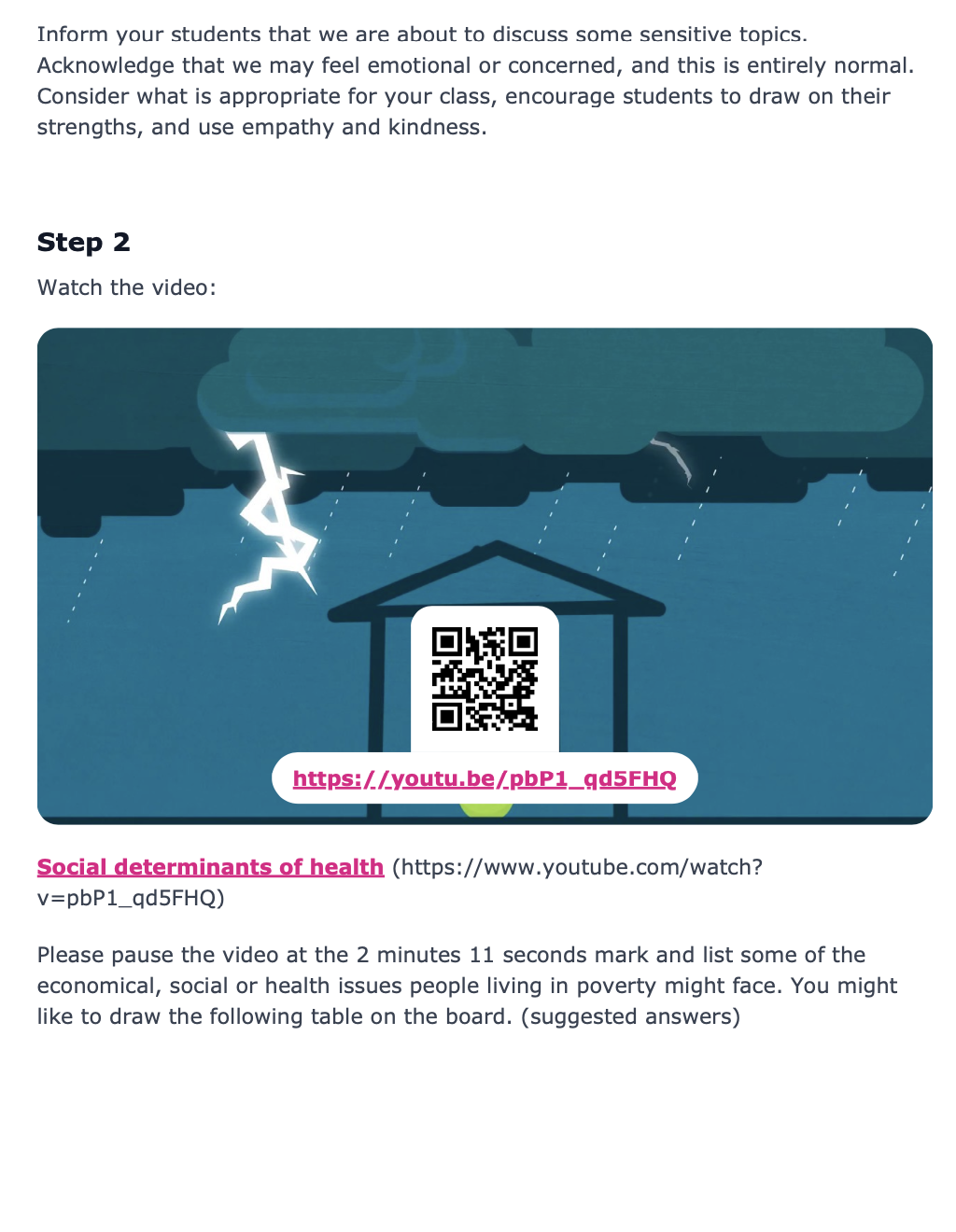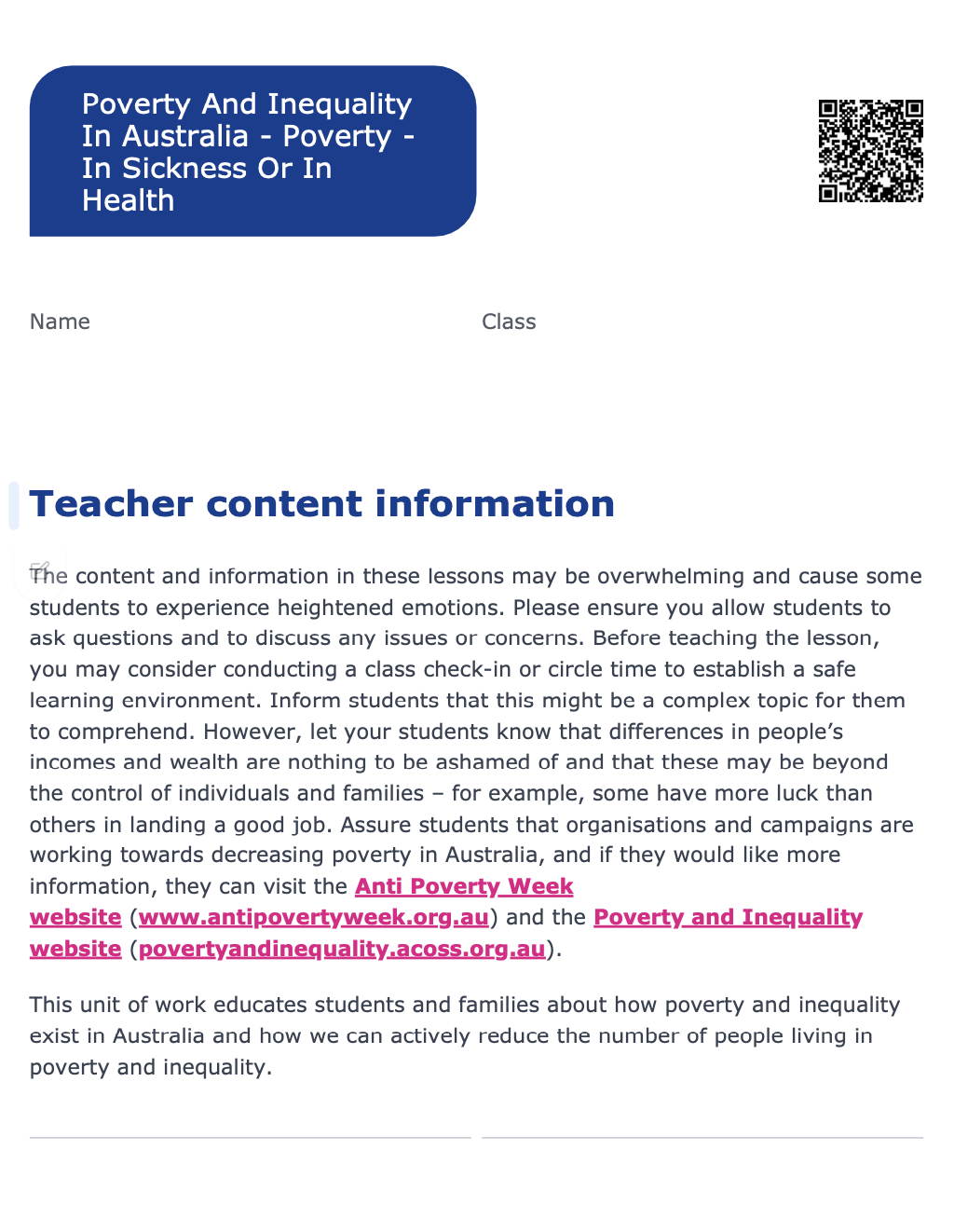Lesson summary
This lesson will introduce students to some health-related impacts of poverty in Australian communities. Students will analyse health and poverty-related data and discuss what this data indicates about poverty, as well as investigate why poverty and health outcomes are intrinsically linked. The class will collaborate and practice teamwork to explore one aspect of poverty-related health, discuss how living in poverty might cause these health problems and offer solutions.
Learning intentions:
Students will...
- understand how living in poverty can impact health outcomes
- understand the relationship between living in poverty, health outcomes and well-being
- discover positive ways our community can help support people living in poverty.
Success criteria:
Students can...
- articulate how living below the poverty line can directly impact health outcomes
- recognise and empathise with health impacts by looking at real-life scenarios
- identify various strategies that might help people living below the poverty line.
Lesson guides and printables
Curriculum links
Select your curriculum from the options below.
Lesson details
Skills
This lesson is designed to build students’ competencies in the following skills:
- creativity
- critical thinking
- empathy
- global citizenship
- initiative
- problem solving
Curriculum Mapping
Australian Curriculum content descriptions:
Years 5 & 6 HPE:
- Investigate community resources and ways to seek help about health, safety and wellbeing (ACPPS053)
- Investigate the role of preventive health in promoting and maintaining health, safety and wellbeing for individuals and their communities (ACPPS058)
Syllabus outcomes: PD3-1, PD3-2, PD,3-3, PD3-10
General capabilities: Numeracy, Personal and Social Capability, Ethical Understanding
Relevant parts of Year 5 & 6 achievement standards:
By the end of Year 6, students explain the influence of people and places on identities. They describe their own and others’ contributions to health, physical activity, safety and wellbeing. They describe the key features of health-related fitness and the significance of physical activity participation to health and wellbeing.
Students access and interpret health information and apply decision-making and problem-solving skills to enhance their own and others’ health, safety and wellbeing.
UN Sustainable Development Goals
UN SDG 1: End poverty in all its forms everywhere
- Target: 1.1: By 2030, eradicate extreme poverty for all people everywhere, currently measured as people living on less than $1.25 a day.
- Target: 1.1: By 2030, ensure that all men and women, in particular the poor and the vulnerable, have equal rights to economic resources, as well as access to basic services, ownership and control over land and other forms of property, inheritance, natural resources, appropriate new technology and financial services, including microfinance.
Resources Required
- Access to the Internet and YouTube
- A device capable of projecting infographics and videos with sound (or some other device to play video clips to the class)
- Poster paper and writing materials OR digital devices and access to collaborative sharing software, such as Padlet (Teachers could set up Padlets for each topic area beforehand and send these links to each group)
- Student Worksheets – one copy per student
Additional Info
Time required: 80+ mins
Level of teacher scaffolding: Medium – teacher will need to set up and show video, scaffold class discussion and inquiry questions, organise student teams and topics and guide the final plenary session
These lessons have been designed in consultation with Anti-Poverty Week and ACOSS/UNSW Poverty and Inequality Partnership.
The content and information in these lessons may be overwhelming and cause some students to experience heightened emotions.
Please ensure you allow students to ask questions and to discuss any issues or concerns. Before teaching the lesson, you may consider conducting a class check-in or circle time to establish a safe learning environment. Inform students that this might be a complex topic for them to comprehend. However, let your students know that differences in people’s incomes and wealth are nothing to be ashamed of and that these may be beyond the control of individuals and families – for example, some have more luck than others in landing a good job.
Assure students that organisations and campaigns are working towards decreasing poverty in Australia, and if they would like more information, they can visit the Anti Poverty Week website and the Poverty and Inequality website.



Welcome back!
Don't have an account yet?
Log in with:
Create your free Cool.org account.
Many of our resources are free, with an option to upgrade to Cool+ for premium content.
Already have an account?
Sign up with:
By signing up you accept Cool.org's Terms and Conditions(Opens in new tab) and Privacy Policy(Opens in new tab).